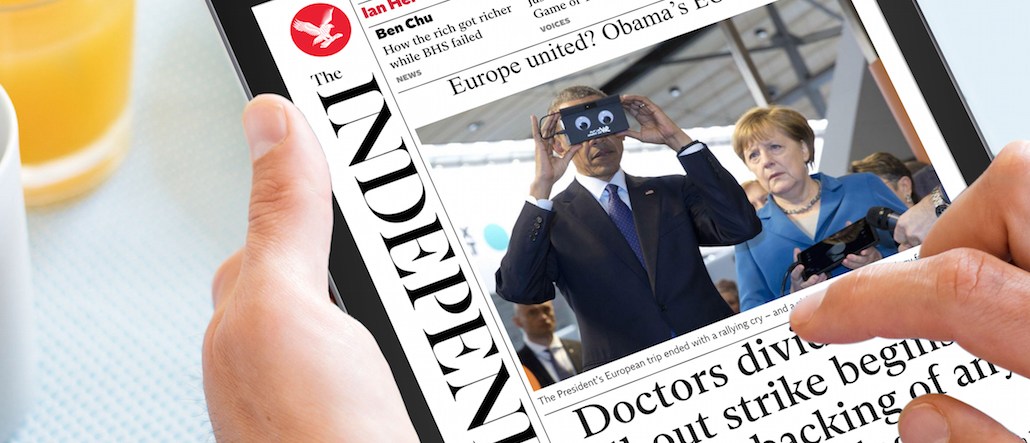
The Independent may have shed the costs of running a print newspaper since it went digital-only at the end of March. But it still has to generate enough cash to maintain its quality journalism online.
Parent ESI Media, which also owns The Evening Standard newspaper, spends around £250,000 a day ($360,000) on the Independent’s editorial operations. That figure’s set to rise, given it’s adding foreign correspondents across Europe, Asia and the Middle East, in the coming months.
Selling its i newspaper to Johnston Press for £24 million ($35m) will provide some financial cushion. But to make sure its revenue keeps pace with its editorial goals, the Independent has hired writers who can moonlight as commercial content creators to hold down content studio costs. It’s also adding programmatic specialists.
Before going online-only, the Independent was holding its own in terms of online traffic, with an average 3.1 million daily browsers, after the Telegraph with 4.2 million and ahead of The Sun’s 2.3 million, according to the Audit Bureau of Circulations.
Scaling the Independent’s audience domestically and internationally is a must, and by bolstering its programmatic team, the site can sell more of its overseas inventory without putting costly sales teams on the ground. It already does this in the U.S., where most of its inventory is sold programmatically. Now it will do the same in Europe and Asia.
The publisher has six programmatic specialists and is hiring another three, one of which will be responsible for audience extensions.
“Our digital component had needed finessing, because the table stakes are much higher now. It’s about delivering competent data sets, delivering the mechanics for programatic trading, and getting closer to editorial for native campaigns — all these are minimum requirements, along with viewability,” said ESI chief digital revenue officer Scott Deutrom.
Around 20 percent of the Independent’s ad revenue comes from programmatic. But 55 percent of the revenue that comes via agency deals is programmatic, he said. One goal is to enable all the ad formats be traded programmatically by the end of the year and introduce header bidding.
Header bidding, which lets publishers widen the number of bidders on their inventory to drive competition, has become a popular way for publishers to get better yields. The Independent wants in on the action, and is on the verge of signing a provider.
“It’s my job to ensure we have as many demand sources as possible to bid on our inventory. Header bidding is a solution that helps us do that, and ensures our SSP is working as hard as it can to value our inventory. I expect it to make a material difference to our revenues,” said Deutrom, who expects to see a 20 percent increase in programmatic revenue from header bidding.
The Independent still commands respect from agencies as an editorial publication, although some believe that the demise of the print paper was not coupled with a loud enough campaign to re-affirm that the digital edition was still alive and thriving. “Sales people are probably getting bored with being asked if the site is still live when calling planners,” said Tim Pearce, head of publishing and radio trading at Dentsu Aegis’ media buying arm Amplify.
And yet, advertiser fears over brand safety, fraud and control in the programmatic world remain high, and an online property like the Independent will be an attractive, safe haven for programmatic ad buyers, added Pearce.
The success of the digital-only proposition will depend on the publisher’s willingness to play ball in the competitive trade desk space, though, he said.
“The majority of direct programmatic buys are data-driven audience buys which rely on scale for cost efficiency,” he said. “The Independent’s relatively limited data capabilities mean that they may find it hard to compete with the large data-focused operators.”
Image courtesy of the Independent.
More in Media

The accidental guardian: How Cloudflare’s Matthew Prince became publishing’s unexpected defender
Cloudflare’s day job is fending off botnets and nation-state cyberattacks, not debating how Google and other AI firms crawl publisher sites.

A timeline of the major deals between publishers and AI tech companies in 2025
Here’s a list of all the major deals signed between publishers and AI tech companies in 2025.

No playbook, just pressure: Publishers eye the rise of agentic browsers
For the bulk of publishers, Google is, as ever, the one to watch. It’s already got agentic features within its Chrome browser, but that’s the tip of the iceberg, some say.





